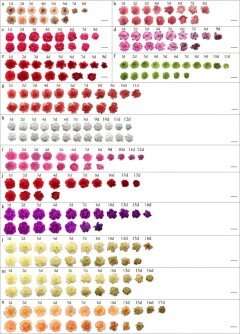This article has been reviewed according to Science X's editorial process and policies. Editors have highlighted the following attributes while ensuring the content's credibility:
fact-checked
trusted source
proofread
Unraveling ethylene's role in carnation postharvest life: Insights into varietal sensitivity and genetic regulation

Carnation (Dianthus caryophyllus L.) is a flower widely cultivated for its appealing appearance and fragrance. However, it faces postharvest challenges that can affect its ornamental quality, primarily due to water stress and microbial growth.
Research has highlighted the significant role of ethylene in the flower's lifespan, with variations in sensitivity and production across different varieties. Key genes involved in ethylene biosynthesis, such as ACS and ACO, have been identified, and genetic manipulation to alter ethylene production has shown promise in extending the vase life of carnations.
However, there is a lack of comprehensive research on the postharvest physiological changes across different carnation species, indicating a critical area for future investigation to improve cut flower preservation techniques further.
Ornamental Plant Research published a paper titled "Differences in ethylene sensitivity, expression of ethylene biosynthetic genes and vase life among carnation varieties."
In this study, 14 commercial carnation varieties were exposed to ethylene gas at a concentration of 10 μL/L for 4 hours to explore the effect of ethylene on the vase life of various varieties. The results showed that the varieties responded differently to ethylene, with 'Master' exhibiting the most significant reduction in vase life post-treatment. Conversely, 'Snow White' showed no change in vase life, indicating minimal ethylene sensitivity.
Furthermore, water content analysis across different senescence stages in selected varieties revealed that ethylene treatment accelerated water loss, particularly noticeable in the complete wilting stage.
Ethylene release measurements provided insights into the varieties' ethylene production patterns, revealing varied responses, with 'Master' displaying a unique peak in ethylene release at 24 hours, contrasting with 'Snow White's' lower ethylene sensitivity.
Gene expression analysis focused on DcACS1, DcACO1, DcEBF1/2, and DcERF-1, crucial for ethylene biosynthesis and signaling. Notably, 'Master' showed a dramatic increase in DcACS1 and DcACO1 expression after ethylene treatment, while 'Snow White' had the lowest increase, which correlates with their ethylene sensitivity.
To further understand ethylene's role in senescence, transient silencing, and overexpression experiments were conducted targeting DcACS1 and DcACO1 genes. As a result, silencing DcACS1 in 'Master' delayed senescence and maintained flower disk whiteness, whereas overexpressing DcACS1 accelerated senescence.
Similar trends were observed with DcACO1, where its silencing delayed senescence and overexpression promoted it, confirming the pivotal role of these genes in carnation senescence.
In conclusion, this study underscores the intricate relationship between ethylene sensitivity, water content regulation, and genetic factors in determining the postharvest lifespan of carnation flowers. It also highlights the potential for genetic manipulation to extend vase life, providing insights for breeding and selecting long-lived carnation varieties and paving the way for future research on the molecular mechanisms governing ethylene-induced senescence in cut flowers.
More information: Min Wang et al, Differences in ethylene sensitivity, expression of ethylene biosynthetic genes and vase life among carnation varieties, Ornamental Plant Research (2024). DOI: 10.48130/opr-0024-0002
Provided by Chinese Academy of Sciences



















